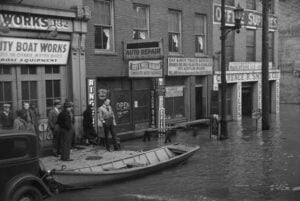A Viking runestone in Minnesota?

The Kensington Runestone in 1910.
The Kensington Runestone is a stone slab, covered in runes, and according to some, carved by Vikings. It was allegedly discovered by a Swedish farmer in Minnesota in 1898.
Since immigrants from Sweden, Norway, and other Scandinavian nations settled in the Upper Midwest, there have been folk stories about Vikings making it to the Midwest centuries before Columbus’ expedition.
But is it a genuine artifact of a Viking expedition to the heart of North America, or a clever hoax?
The story of the Kensington Runestone discovery
The story goes that Olof Öhman, a Swedish immigrant who settled in Solem Township, Douglas County, Minnesota, was clearing some land on his farm in 1898. He stumbled upon a large stone in the roots of a poplar tree. He pulled out the stone and noticed that it had strange symbols carved on its face and one side. He allegedly didn’t know exactly what they meant, but he recognized them as runes. He took the stone home and showed it to his neighbors. They also identified the symbols as ancient runes and noticed that the stone had a date: 1362.
The find became a regional sensation. Minnesota journalists covered the story and it was even put on display at a local bank.
The 202-pound stone soon attracted the attention of scholars and curiosity seekers, who tried to decipher the inscription. A copy of the stone was sent to the University of Minnesota and they concluded it was a forgery. The university sent copies to scholars in Scandinavia where they made the same conclusion.
The translation
The generally accepted translation of the runes reads: “We are 8 Goths [Swedes] and 22 Norwegians on an exploration journey from Vinland through the West. We had camp by a lake with 2 skerries [small rocky islands] one day’s journey north from this stone. We were out and fished one day. After we came home we found 10 of our men red with blood and dead. AVM [Ave Virgo Maria, or Hail, Virgin Mary] save us from evil. We have 10 of our party by the sea to look after our ships, 14 days’ journey from this island. Year 1362.”
After many scholars declared it as a fake, Ohman allegedly started using it as a doorstep. There the stone remained until Hjalmar Holand, a young Norwegian American, scholar/farmer/book salesman, resurrected the story in 1907. He became its biggest promoter, and vigorously defended the Runestone’s authenticity for the next 50 years.
Holand said the stone proved that the Vikings had not only reached North America, but had ventured far inland, almost 500 years before Columbus. Others suggested that there might be more evidence of Norse presence in the region.
Minnesota’s Scandinavian heritage
The Upper Midwest in the early 1900s, had an abundance of Scandinavian immigrants.
During this period, Leif Ericson’s journey to North America was widely discussed. Ericson’s legend brought pride to the new immigrants, giving them a place in the history of the nation. Instead of feeling like outsiders, they could feel like they deserved to be there more than any other white ethnicity.
Five years earlier Norway sent a replica of the famous Gokstad Viking ship to the World’s Columbian Exposition in Chicago, IL. This made international headlines and brought immense pride to Scandinavian Americans.
Meanwhile, having a story like the Kensington Runestone, directly linking their newly adopted land to their ancestors, amplified their nationalist pride.
(Whether it was Ericson or a different group of Vikings, they conclusively settled in modern-day Nova Scotia, Canada).

The Kensington Runestone’s authenticity
Numerous experts have dismissed the Kensington Runestone as a hoax. They argue that the runes are not consistent with the ones used in the 14th century.
Henrik Williams, a professor of Scandinavian languages who specializes in runology, has written that “In my best judgment as an expert in the field, I cannot find that the [Kensington Runestone] inscription looks like any medieval Scandinavian text I have ever seen.”
The stone is also too smooth and fresh-looking for being buried for centuries.
Geologist Harold Edwards wrote in 2016 that “the inscription is about as sharp as the day it was carved… The surface of the calcite layer shows the granular texture that is typical of weathered calcite so it was weathered for some time. The letters are smooth showing virtually no weathering.”
However, organic material tests revealed the stone had possibly been buried for about 25 years before Öhman found it, suggesting the Swedish farmer may not be a hoaxer,
Ohman’s possible motives
A group of critics believed Olof Öhman had a motive to fake it. They accused him of being a prankster who wanted to fool his neighbors or make some money by selling the stone.
Ohman was rumored to own books on runic writing. Investigators inspected his small library and removed a copy of an 1840 Swedish grammar text, which contained a table of runes,
In 1909, Olof, his son Edward, and their neighbor, Nils Flaten, sworn affidavits regarding their recollection of the day the stone was discovered.
The original affidavits were lost. But a scholar critical of the stone named J.A. Holvik, studied copies provided by Holand. Holvik discovered multiple inconsistencies.
First, the notary official that oversaw the affidavits was not properly licensed until 16 months later. Holvik believed this gave the witnesses permission to lie without technically perjuring themselves.
The men also gave inconsistent accounts of where the stone was discovered and when. They also had inconsistent descriptions of the tree the stone was under.
Holvik believed it was a prank that got out of hand. Ohman and his friends allegedly despised academics. Holvik also believed Ohman discovered the unmarked stone slab and chiseled the inscription sometime after 1897. After allowing the stone to weather, he then “rediscovered” it in November 1898.
The legend of the stone lives on
The debate over the Kensington Runestone has continued for over a century. Scholars overwhelmingly believe it to be fake, however, the stone still provokes a host of popular articles and books on it. The Minnesota Historical Society library carries more than forty titles on the subject. The slab has been examined in Europe and displayed at the Smithsonian Institution, and the 1965 New York World’s Fair.
Pseudo-historians have made outlandish claims, even connecting the stone to the Knights Templar. Many people living in Minnesota still believe in the Kensington Stone’s authenticity. Minnesotans have even attacked the character of scholars that have worked to debunk the stone. J.A. Holvik was publically attacked in newspapers throughout Minnesota and received threatening letters throughout his life.
Heated comments supporting the stone in editorials, forum boards, and social media still occur to this day. For some Scandinavian Americans, it seems like questioning the authenticity of the stone is an attack on Scandinavian heritage.
The Kensington Runestone is currently on display at the Runestone Museum in Alexandria, Minnesota.



